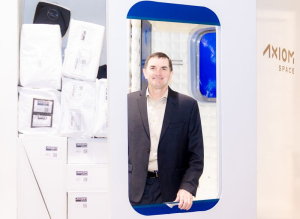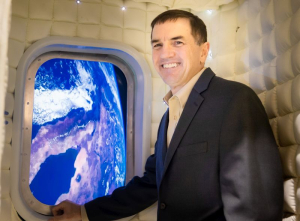When Rex Walheim first enrolled at the University of Houston's Cullen College of Engineering's Masters program in Industrial Engineering in the 1980s, his goals were literally sky high. At the time, he was a flight controller at the Johnson Space Center and a lieutenant in the United States Air Force, and he hadn't yet flown a vessel himself.
“I knew that an advanced degree was important for a career in the Air Force,” he said. “I was interested in becoming an Air Force Flight Test Engineer, which required an Engineering Masters degree. A friend of mine told me about the UH Industrial Engineering program and it sounded interesting. I decided to try it out, and ended up enjoying it. I found that it was a good mix of engineering and management.”
After completing his Masters at UH in 1989, he managed a program to upgrade missile warning radars, followed by the Flight Test Engineer course at the Air Force Test Pilot School in 1992. Following his graduation, he was assigned to the F-16 Combined Test Force at Edwards where he was a project manager and then commander of the avionics and armament flight. In January 1996, Walheim became an instructor at the Air Force Test Pilot School, where he served until he commenced astronaut training.
“Completing my Industrial Engineering degree at UH was absolutely essential to my ability to be selected as a Flight Test Engineer, and to eventually become an astronaut,” he said.
He was selected by NASA as an astronaut in March 1996, and reported to the Johnson Space Center in August 1996. After completing 2 years of training and evaluation, he qualified for flight assignment as a Mission Specialist. His first trip was from April 8 through April 19, 2002, a delivery mission to the International Space Station. He completed two spacewalks, totaling more than 14 hours.
Walheim described the process of blasting off into space in a 2002 profile in “Parameters.”
“I had a little wrist mirror that I had on my left arm so I could look out the overhead window behind us, and when the main engines came up I could see the smoke from the exhaust coming up,” he said. “A little later I looked up again and I could see the beach out the back window, and I could see it just fading away. It was just really amazing to see how fast we were climbing. You’re going about 100 miles per hour by the time you clear the pad so it doesn’t take long. You’re really screamin’.”
Given the sometimes contentious relationships between the nations on the ground, Walheim said that the international collaboration needed for the ISS and other projects was often overlooked.
“I think people don’t appreciate what a great example of international cooperation the space program is,” he said. “There are obviously big challenges in the relations of the United States and Russia, but the cooperation in space is amazing. For more than 20 years, we have been great partners in space, working together, living together and solving problems together. The same is true with our European, Japanese and Canadian partners. It is incredible how well you can get along when you have important common goals and a shared need to survive in a very inhospitable environment.”
Looking back at his days at UH, Walheim had fond memories of several professors.
“One of my favorite professors at UH was Dr. John Hunsucker,” Walheim said. “He was a very colorful lecturer. When he wanted to clarify a point he was making, he would commonly preface it with the phrase, 'Now for the slow learners and graduate students…' I also enjoyed taking classes in the business school as part of the program. One of my favorite professors there was Dr. Janelle Dozier. She taught an Organizational Behavior class that I found especially interesting.”
Walheim balanced his work at the space center with his work pursuing his degree, like many students do now.
“For about the first year and a half of the Masters program, I was working full time, and taking classes in the evening,” he said. “Although it was busy, I enjoyed switching gears on class days and being a student again. The Air Force allowed me to take classes full time to finish my last six months of the program.”
Walheim retired from NASA as the deputy director of the Johnson Space Center's Safety and Mission Assurance Directorate in July 2020. The agency noted that he spent almost 36 years in government service, 36 days in space, and 36 hours on spacewalks. He still works for a space company and with the ISS, although in the private sector, with Axiom.
“At Axiom Space, we are building commercial modules that we will add onto the International Space Station,” he said. “These modules will make up a segment of the station where governments or private individuals will be able to do research, manufacturing, marketing, educational outreach and many other activities.”
The company has also made headlines for its goal of sending private astronauts aboard the space station.
“We hope to fly our first Private Astronaut Mission late next year,” Walheim said. “I am the Director of Safety and Mission Assurance at Axiom, so I help to make sure our crews fly safely and that our modules and systems are built robust enough to effectively accomplish our missions. I also ensure that our company’s employees are able to do their jobs safely here on Earth.”

